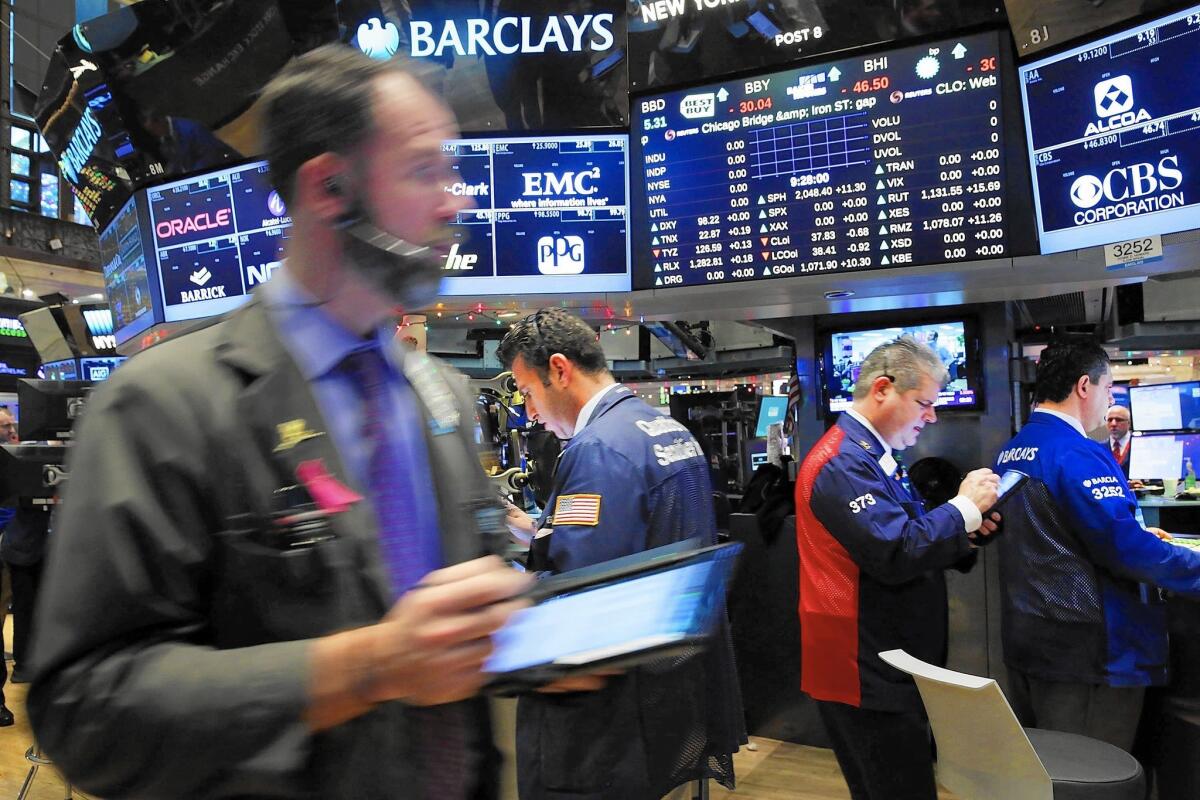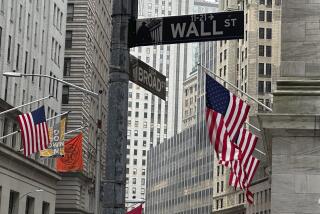Tallying the winners and losers in a volatile year for markets

Major U.S. stock indexes are poised to end 2015 little changed for the year. But under that seemingly calm surface were some dramatic swings in global markets, making for some very big winners as well as big losers in stocks, bonds, commodities and other investments.
Indeed, 2015 may be remembered mostly as a year of wild divergences in markets. You could more than double your money in a stock like Netflix — or lose more than half your money in what had appeared to be a promising young shale-oil driller.
Here’s a look at some of the year’s most significant market trends and the winners and losers they created:
Winner: The dollar
Losers: Commodities and emerging markets
Americans like to complain that the dollar doesn’t buy much anymore. But measured against other major currencies, the greenback is the world’s strongman: It now buys the most in about 13 years.
An index that tracks the dollar’s value against six key currencies, including the euro and the yen, has jumped 8.4% in 2015 after a 13% surge in 2014.
The dollar has been driven in part by the U.S. economy’s strength compared with many other nations. Although U.S. growth has been modest, it still has outshone growth in much of the rest of the developed world. Stronger economies tend to attract more investment, in turn driving up demand for their currencies.
The Federal Reserve’s decision to raise its benchmark short-term interest rate this month for the first time since 2006 — to a minimum of 0.25% — also has bolstered the dollar by giving foreign investors another reason to move money here.
A rising greenback is great for American tourists abroad. One dollar now is worth $1.39 Canadian, up from $1.06 two years ago. Likewise, a robust dollar can make foreign exports cheaper for U.S. consumers.
But for U.S. multinational companies, “The dollar has caused all kinds of problems for sales and profit growth,” notes Doug Ramsey, chief investment officer at Leuthold Weeden Capital Management in Minneapolis. Sales and earnings in weaker currencies translate into fewer dollars. That has depressed many multinationals’ financial results this year, undercutting their stocks.
What’s more, because commodities like oil and grains are priced in dollars worldwide, those raw materials become more expensive for buyers in countries with weak currencies. That has helped hammer global commodity prices, a decline made worse by China’s economic slowdown and by the global glut of oil. U.S. crude oil fell $1.29 to $36.81 a barrel on Monday, and now is down 39% in 2015. It’s the lowest price since 2009.
Crude’s crash is a bonanza for American consumers. But for emerging-market economies that are commodity exporters, such as Russia and Brazil, the dollar has been a double-whammy: It has depressed the prices of their exports while driving up the cost of U.S. goods and services. The result has been a rout in emerging-market stock markets, long popular with U.S. small investors. The share price of the iShares MSCI Emerging Markets exchange-traded fund has dived 17% this year and is near its lowest level since 2009.
Many analysts expect the dollar to continue to climb in 2016. Marc Chandler, a veteran currency markets analyst at Brown Bros. Harriman in New York, notes that the divergence in interest rate policies between the Fed and central banks in Europe, Japan and elsewhere is becoming more stark. “The Fed is becoming less accommodative while other central banks maintain or extend current easing policies,” he says.
Even so, some experts believe that battered emerging-market economies are poised for a turnaround. In its new year’s outlook, BofA Merrill Lynch Global Research forecasts that “about three-quarters of emerging-market economies could show signs of recovery by the middle of 2016.”
NEWSLETTER: Get the day’s top headlines from Times Editor Davan Maharaj >>
Winners: Cult growth stocks
Losers: Classic value stocks
In a tepid, at best, global economy, investors hunting for growth-stock ideas faced ever-slimmer pickings in 2015. At the same time, anticipation of higher interest rates slammed many classic dividend-paying “value” stocks, such as utilities, that compete with bonds for investors’ attention.
The result has been a two-tiered stock market: Investors have stampeded into a relative handful of cultish growth companies, notably the so-called FANG group: Facebook, Amazon, Netflix and Google parent Alphabet Inc. Those shares are up 36%, 118%, 140% and 47% this year, respectively.
Much of the rest of the market, meanwhile, has struggled. The blue-chip-dominated Standard & Poor’s 500 index is down 0.1% year to date. The damage has been far worse in some stock sectors.
The Dow utility stock index is off 5.8% this year. The Dow transportation stock index is down 17.2%.
And commodity-related stocks have been devastated. The Energy Select Sector SPDR exchange-traded fund, which owns major energy shares, has plunged 24%.
The sharp disparity between the cult growth stocks and the broader market is a warning sign that the 6-year-old bull market is running out of steam, says James Stack, a market historian and editor of the InvesTech Research market newsletter in Whitefish, Mont.
“The type of highly concentrated performance by extreme valuation stocks is seldom, if ever, a sign of a healthy bull market,” he says.
Similarly, nervous investors have begun to shun stocks of smaller companies, which had been leading the bull market even though they typically are considered riskier than blue-chip stocks.
The Russell 2000 index of smaller stocks rose 93% from the end of 2009 to the end of 2014, beating the S&P 500 index’s gain of 85%. But this year the Russell index has fallen 4.7% while the S&P is flat.
Some money managers who focus on relatively unglamorous small-company stocks, such as in manufacturing, say the declines could be setting up for a new appreciation of value stocks in the next few years.
That’s what happened from 2000 to 2002, when high-flying tech stocks crashed and many investors turned to depressed shares of companies with solid if unspectacular earnings growth.
Chuck Royce, chief executive of New York-based Royce Funds, a small-stock, value-oriented manager, believes that investors will begin to “look more closely at [companies’] balance sheet strength and profitability,” which could favor many stocks that now take a back seat to the FANG types.
SIGN UP for the free California Inc. business newsletter >>
Winners: Tax-free muni bonds
Losers: Junk corporate bonds
Stock markets and currency markets didn’t have a monopoly on big disparities in performance this year. In the bond market, corporate high-yield “junk” bonds tumbled in value as many investors fled. Meanwhile, tax-free municipal bonds became a haven for investors seeking income and relative safety.
The junk market — bonds of companies considered below investment-grade, and thus high risk — continued a decline that began in mid-2014. At that point the market was enjoying extraordinary demand as money poured in from yield-hungry investors. The average yield on an index of junk bonds tracked by BofA Merrill Lynch neared a record low 5% in June 2014.
Then, suddenly, demand began to ebb. One factor was the beginning of the plunge in oil prices, which caused many investors to back away from junk debt issued by young energy companies, on fears of default. Another factor: rising expectations that the Federal Reserve was getting closer to hiking short-term interest rates from near-zero levels.
By the end of 2014 the average junk yield was 6.7%. This year the average has shot up to a recent 9.1%, the highest since 2011, as some investors have continued to bail out.
Dan Fuss, manager of the Loomis Sayles Bond fund in Boston, concedes that he has had a lousy year, with his fund down 6.7% year to date, counting both price depreciation and interest earnings. The fund has about 33% of assets in junk securities. But Fuss, who has been investing in bonds at Loomis Sayles since 1976, notes that the junk bond market has a history of wild volatility. He thinks investors have overreacted to both economic jitters and interest rate concerns, and says he has been selling safer bonds such as U.S. Treasury issues to buy more junk. “The high-yield market is really cheap now,” he says.
There’s no guarantee it can’t get cheaper. But Russ Kinnel, director of mutual fund research at Morningstar Inc., says investors should think about starting to nibble at junk funds. “People have been waiting for years for something to pay a decent yield,” he says.
While junk bonds have been trashed, investor demand has risen for tax-free muni bonds. Including price appreciation and interest earnings, the average mutual fund that owns long-term California muni bonds is up 3.6% year to date, according to Morningstar. Because muni interest is tax exempt, the true return is higher.
Marilyn Cohen, a muni bond specialist at Envision Capital Management in El Segundo, says investors have turned to munis as the economic recovery has bolstered the finances of many state and local governments. Glaring exceptions — such as Puerto Rico and Illinois — haven’t rattled most muni owners.
Investors also have been drawn to munis as some formerly popular income investments, such as energy master limited partnerships, have suffered steep sell-offs.
Cohen says the safest strategy for muni investors is to focus on “revenue” bonds, which is debt backed by specific tax or fee revenue — from water or power projects, for example.
Winners: Low-fee “passive” mutual funds
Losers: High-cost “active” stock pickers
For as long as mutual funds have been around, investors have been warned to stay away from funds that charge high management fees. In the last few years that message has registered on a massive scale with many small investors. The proof is in the cash they’re plowing into Vanguard Group, the leader in low-cost funds.
Year to date through November, Vanguard took in a net $206 billion in new money from investors, according to Morningstar. That boosted Vanguard’s total fund assets to $3 trillion.
No other fund company has come close to Vanguard’s take this year. Its arch rival Fidelity Investments has had a net inflow of just $9 billion. The American Funds’ group’s inflow is $10 billion. And the Pimco Funds, still reeling from management upheaval in 2014, have seen a net $78 billion flow out of its portfolios, according to Morningstar.
Vanguard’s allure isn’t just low fees, of course. It’s also the leader in “passive” investing, meaning that rather than trying to beat the market return, most Vanguard funds simply seek to match the average return of a particular market.
That concept, too, has resonated with a growing number of individual investors who’ve been disappointed with “active” managers’ investment strategies that all too often fall short of beating the market average.
This year, Vanguard’s success at drawing more Americans to embrace passive investing has contrasted with disappointing results from some high-profile hedge fund managers, including David Einhorn of Greenlight Capital, Bill Ackman of Pershing Square Capital and John Paulson’s Paulson & Co.
When financial markets crashed in 2008, some analysts expected investors to turn against Vanguard funds that offered no protection from the markets’ deep declines. Instead, the idea of rolling with the average return — up or down — has continued to gain appeal among many small investors.
While financial fads come and go, low-cost, passive investing has proved its staying power.
“It’s hard to imagine this going away,” says Morningstar’s Kinnel.
MORE: Get our best stories in your Facebook feed >>
MORE BUSINESS NEWS
Commerzbank sues Wells Fargo over losses on mortgage-backed securities
Worker salaries are poised to climb in 2016
False advertising lawsuits against SeaWorld dismissed






